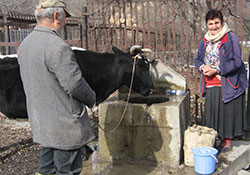Situation assessment of small-scale water supplies in rural Georgia

WHO/Enkhtsetseg Shinee
Background and objectives
The provision of safe and acceptable drinking-water frequently represents a challenge to small-scale water supplies. About half of the Georgian population lives in rural areas and use water from small systems, such as local wells or springs. Up-to-date data on water quality is limited due to lack of capacity for ongoing surveillance. Therefore, WHO/Europe provided support in 2011–2012 for a systematic assessment of the situation of small-scale systems to gain a better understanding of the needs and required actions to further improve safety of drinking-water in rural Georgia.
Activities
In the framework of the project the following activities were carried out:
- a rapid assessment of drinking-water quality and prevailing sanitary risk factors in two pilot districts (Dusheti and Marneuli) using WHO methodologies and tools, including analyses of priority microbiological and chemical parameters and sanitary inspections at 260 sites;
- training of local authorities on safe management of water supplies and prevention of water-related diseases;
- development of awareness-raising materials on water safety and hygiene in Georgian for the local population and implementation of outreach programmes in rural communities;
- translation of WHO water safety plan resource materials into Georgian and dissemination to relevant stakeholders.
Results and achievements
The results of the project provided a baseline on the situation of small-scale water supplies in the two pilot districts. Key findings included the following.
- A significant proportion of the water supplies showed microbial contamination. About two thirds of the water samples were non-compliant with the national standard for Escherichia coli, a microbial indicator signalling faecal contamination.
- Chemical contamination is currently not of primary concern. The vast majority of water samples tested for seven priority physico-chemical parameters were compliant with national standards.
- In most small-scale water supplies, drinking-water is not disinfected. In supplies where chlorination is in place, existing practices were found to be inadequate.
- Standardized sanitary inspections revealed a number of risk factors potentially compromising the provision of safe drinking-water. They include lack of sanitary protection zones, poorly located on-site sanitation facilities and inadequately designed and maintained abstraction facilities.
- Based on water quality and sanitary inspection findings, 40% and 24% of the investigated sites in Marneuli and Dusheti, respectively, could be categorized as at “high” or “very high” risk, requiring urgent attention in terms of improvement needs.
The results of the situation assessment reflect the situation in the two pilot districts only. However, they may also give an indication of the challenging conditions in other areas of rural Georgia. The project outcomes will serve as an evidence base and starting point for further development of the rgulatory framework with regard to small-scale water supplies, including uptake of the water safety plan approach.
Partner support
The project was funded by the German Federal Ministry for the Environment, Nature Conservation, Building and Nuclear Safety and technically supported by the WHO Collaborating Centre for Research on Drinking Water Hygiene at the German Federal Environment Agency. The National Centre for Disease Control and Public Health and the Georgian Environmental and Biological Monitoring Association were responsible for project implementation.



